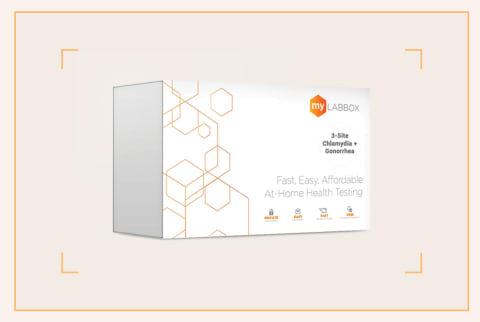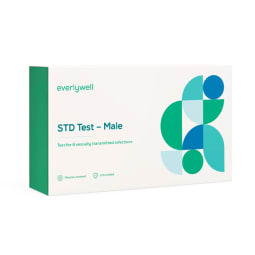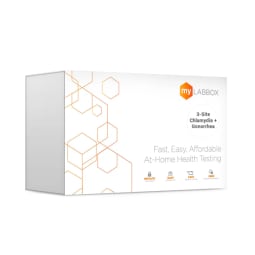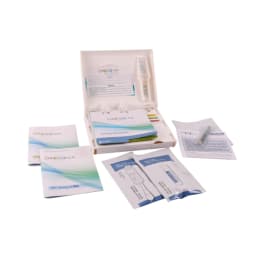Advertisement
The 5 Best At-Home STI Tests In 2023 + What To Know About Them



Moans and groans. Oohs and aahs. Pleasure and pleas. In a dream world, sex would only be about these feel-good components. Unfortunately, there are also some risks to sex, such as unwanted sexually transmitted infections (STIs). Currently, one in five people in the United States has a genital, anal, or oral STI, according to the Centers for Disease Control and Prevention1. The good news is, it's easier than ever to get tested, and you can even do it from the privacy of your own home these days thanks to at-home STI kits.
Broadly speaking, if detected, STIs are no big deal. All sexually transmitted infections can be cured or treated, after all. "Sexually transmitted infections are only dangerous if you do not know that you have one," says Emily Rymland, DNP, FNP-C, a doctor of nursing practice, AAHIVS-certified HIV specialist, and director of clinical services at Nurx. Left undetected, sexually transmitted infections can progress into sexually transmitted diseases (STDs), which means they cause unfavorable symptoms and/or other issues. If gonorrhea or chlamydia are left untreated, for example, they can cause pelvic inflammatory disease and infertility, she says, while syphilis can cause dementia, paralysis, and even blindness if left untreated.
Thankfully, at-home STI tests make it as easy as ever to find out your current STI status. "At-home STI tests give people the opportunity to learn more about their own bodies and health, right from the comfort of their own home," says Rymland. Best, they're usually affordable and nearly foolproof.
Read on for a roundup of the best at-home STI tests on the market depending on what you want to get tested for, as well as your gender, sex, sexuality, and budget.
A quick look at the best at-home STI tests in 2023:
What is an at-home STD test?
An at-home STI or STD test allows you to test yourself for sexually transmitted infections right from your own home. Designed to make getting information about your own health even easier, these at-home tests use Q-tip swabs, a finger prick, and/or urine—depending on the specific STIs the test can detect—to tell you whether or not you have an STI (at the time of testing).
These tests are a great option for anyone who doesn't have time to go to a testing center during the hours their local testing center is open, doesn't have access to transportation to get to a testing center, or who for their own reasons prefers to avoid doctor office settings, says certified sex therapist Jordan Soper, PsyD., CST.
"They also tend to be less expensive than testing at a commercial testing lab or urgent care, making them ideal for people who don't have health insurance," adds Rymland.
How do at-home STD tests work?
Exactly how the at-home STD test works—as well as exactly what they measure—varies based on the specific test and what it's testing for.
To understand why there might be differences between the different STI tests, you need to understand a bit more about sexually transmitted infections, generally speaking.
There are three main types of sexually transmitted infections:
- Parasitic
- Bacterial
- Viral
Parasitic STIs (like trichomoniasis) and bacterial STIs (like gonorrhea and chlamydia) are typically considered site-specific. This means if you contract the STI rectally, it stays in the rectal region, while if you contract it vaginally, it stays in the vaginal region. Parasitic and bacterial STI tests are usually detected either through a urine sample, or throat, anal, penile, or vaginal swab.
Viral STIs (like HIV and herpes), on the other hand, are typically considered full-body pathogens, which means they don't infect just one body part but instead live in the body. Vital STIs are usually tested for through a blood test, such as a finger prick, though recent innovations may make saliva tests possible, too.
How we picked:
What they test for
Some at-home STI kits test for a handful of STIs, while others test for just one or two. In this roundup, we included a variety of tests that test for one, some, and most STIs.
Price
At-home STI tests are convenient, but that additional convenience shouldn't put you out financially too much. That's why we made sure to include at-home testing kits across a range of price tags.
Result speed
People often want STD tests with instant results, so we prioritized result speed in our selections. Between shipping and actual result testing, at-home STD tests typically take five to 10 days for results to come in, though we did include one option that features an impressive two-day turnaround.
Our picks for the best at-home STI tests in 2023:
Best for penis owners: Everlywell Male STD Test

Pros:
- Tests for 6 common STIs
- Discreet packaging
- Easy, pain-free self-collection
- A physician will reach out if you test positive
- Easy-to-understand results
Cons:
- Does not test for oral or anal STIs
- Does not test for herpes
- Not available in all states
What it tests for:
HIVgonorrheachlamydiasyphilistrichomoniasisHepatitis CType of collection:
Finger prickUrine sampleResults available:
Online in 7-10 daysThe CDC may not have an STI frequency recommendation for all men (more on this below!), but that doesn’t mean men can’t test positive for and transmit STIs. “Men are not immune from STIs,” says Rymland. Most experts recommend the same testing frequency for men as any other gender, she says. Meaning, once per year or before/after a new partner, whichever comes first.
Thankfully, Everlywell makes it easy for men and other people with penises to get tested for six common STIs (HIV, gonorrhea, Hepatitis C, chlamydia, syphilis, and trichomoniasis) right from their own home or dorm room.
Simply order the Everlywell Male STD Test online, prick and pee in private, ship your samples back in the prepaid discreet packaging, then wait for your results. After your results are viewed by a physician based in your state, they will get delivered to you digitally in a very easy-to-understand spreadsheet. If you do test positive, an Everlywell physician who can prescribe treatment will call you about next steps.
Best for chlamydia & gonorrhea: myLAB Box 3-Site Chlamydia & Gonorrhea At Home Kit

Pros:
- Tests for anal, oral, & genital gonorrhea & chlamydia
- Comes with pre-addressed, pre-paid label to the lab
- Easy, pain-free self-collection
Cons:
- Only tests for 2 infections
- Have to retest after treatment for positive result
- Expensive
What it tests for:
gonorrheachlamydiaType of collection:
Vaginal swabUrine sampleResults available:
Online in 3-5 daysChlamydia and gonorrhea make up the majority of new STI cases each year, according to the CDC, and this at-home STI test from myLAB Box allows you to test for both of them. Most notably, it doesn’t just check for genital gonorrhea and chlamydia; it checks your throat and anus for infection, too. (There's also a version available on Amazon, though it only tests vaginally.)
The only downside of this option is that if you test positive, you’ll have to take a “test of cure” a few weeks after treatment. This is standard as far as bacterial STIs are concerned, but is a bit of extra hassle when you’re using an at-home—rather than office—test. If you test positive, myLab Box will also suggest you with a physician in your state, but you’ll have to do the legwork to connect with them yourself.
Advertisement
Pros:
- Discreet packaging
- Easy, pain-free self-collection
- A provider will reach out if you test positive
Cons:
- Does not test for anal STIs
- Does not test for any strain of hepatitis or herpes
- Does not test for other infections & imbalances like bacterial vaginosis or yeast
What it tests for:
HIVgonorrheachlamydiasyphilistrichomoniasisType of collection:
Throat swabFinger prickVaginal swabResults available:
Online in 7-10 daysHave a vagina and want to know your current STI status? Look no further than the Nurx Healthy V At-Home STI Test, which allows you to test for HIV, gonorrhea, chlamydia, syphilis, and trichomoniasis without going into a clinic.
Despite what the name implies, this test doesn’t just test for vaginal STIs—it also tests for oral STIs, making it a great option for anyone enjoying barrier-free oral.
Best of all, purchase this kit and you’ll get access to the queer-inclusive, trauma-informed Nurx healthcare providers whether you test positive or not. If you test positive, a Nurx provider in your state will prescribe your medication. Very useful!
Pros:
- Very fast results
- No blood collection required
Cons:
- Only tests for HIV
- More testing may be required
What it tests for:
HIVType of collection:
Throat swabResults available:
20 minutesThis at-home HIV test from OraQuick is affordable, pain free, and offers near-immediate results.
Using this test is easy. Simply swab your cheeks, then wait 20 minutes while your results register. OraQuick has a 24/7 support call center that you can utilize while you wait, or after you receive your result.
One thing to keep in mind is that OraQuick is generally regarded as a first-step. If you test positive, you’ll need to go to an in-person lab to confirm (or deny) the results. Similarly, if you test negative but just two weeks have passed since the potential exposure, you’ll need to re-test.
Advertisement
Pros:
- Very fast results
- Tests for high number of STIs at once
- Includes doctor phone consultation if results are positive
Cons:
- Samples must be given at a testing center
- Does not test for trichomoniasis
- Does not test for anal or oral STIs
What it tests for:
HIVgonorrheachlamydiasyphilisHepatitis CHepatitis AHepatitis BHerpes types I & IIType of collection:
Urine and blood collection at a labResults available:
Online in 1-2 daysLooking to be tested for as many STIs at once as possible? This STDCheck.com Full Panel STD Test is your best bet. This one tests for an impressive 10 different types of STIs.
The main downside of this option is that the samples must be collected at one of STDCheck.com’s 4500 testing centers, rather than from home. Thankfully, the website says the entire urine and blood collection process takes under 5 minutes. If you’re someone who has a hard time following directions or who is otherwise worried about messing up the self-collection process, this switch is probably a pro.
Bonus: Your results are sent to your email as soon as they’re available, which typically takes just 1 to 2 days.
When to use an at-home STD test.
You could use an at-home STI test anytime you want to know your current STI status. You might want to get STI tested, for instance, if you have sex without a condom or have barrier-free oral with a new partner or someone who you believe may have other undisclosed sexual partners.
Whether you test yourself by going to a doctor's office or screening yourself from home, however, you need to remember that STIs have an incubation period.
When you are first exposed to an STI, it takes time for your body to recognize the infection and create protective antibodies in response to it, explains Soper. The antibodies are what most of these tests are looking for. If you take an at-home STI test before your body has had time to respond to the infection, you will get a false negative.
That's why the National Health Service recommends waiting two to three weeks after a potential exposure to test yourself. Viral STIs like hepatitis, HPV, and HIV can take even longer than that to appear.
The best way to ensure accurate results is to test yourself at least two weeks after potential exposure (read: sexy time with someone whose STI status you don't know or who you know to have a positive STI status) and then again two or three months after exposure.
Are at-home STD tests accurate?
Yes. So long as you follow the self-collection instructions exactly as they are written, at-home STI test results are accurate. In fact, most at-home STI collections are sent to the same labs as the collections gathered at a doctor's office.
How often should you take an STD test?
Currently, the Centers for Disease Control and Prevention2 recommends that sexually active women get tested at least once each year for gonorrhea and chlamydia, while gay and bisexual men get tested for those two as well as syphilis. The CDC offers no official recommendations for straight men, which is frankly disappointing.
As it goes, most health care professionals think these recommendations are inefficient. "It should go without saying, but men can get STIs and pass those STIs onto their sexual partners, no matter their gender," says Felice Gersh, M.D., author of PCOS SOS: A Gynecologist's Lifeline To Naturally Restore Your Rhythms, Hormones, and Happiness.
So, what's a better rule of thumb? Before every new sexual partner, according to Erin Flynn, an NP and health care expert with Favor. "Patients should get checked for STI—either at a clinic or using an at-home test—prior to having sex with a new partner and asking that they do the same," she says.
People should get tested more frequently than that if they begin to experience unusual symptoms. While the majority (nearly 70%) of STIs are asymptomatic, sometimes people will experience STI symptoms, such as pain while peeing, discomfort during sex, itchiness, lumps and bumps, blisters or sores, and unusual discharge. If you experience any of these symptoms, or any other genital, anal, or throat abnormalities, you should test yourself for all STIs.
Left untreated, some STIs can have serious consequences such as neurological conditions, infertility, scarring, and more, says Rymland. And of course, left untreated, there is also the risk of transmitting the infection to your other sexual partners, she says.
When to see a doctor.
Experiencing unusual symptoms but test negative for all the STIs your at-home STI test detects? Head to the doctor, says Soper. You may have another sexually transmitted infection or another infection like a yeast infection, bacterial vaginosis, or urinary tract infection. If you're experiencing pain and discomfort, it could also be another underlying condition such as endometriosis or uterine fibroids.
A doctor will be able to help you understand exactly what's going on with your body and provide the proper treatment or care depending.
Where to get an STD test for free or low cost.
At-home STI tests are a great option for people who don't have health insurance or who are otherwise on a budget. But there are free and low-cost ways to get tested in person, if you'd prefer to have one-on-one access to a provider to ask all your STI and other sexual health questions to.
The following locations often offer low-cost or free STD testing:
- Your local, city, or state health department
- Planned Parenthood
- LGBTQIA+ centers
- University or college campus clinics
FAQ
Can I test myself for chlamydia at home?
Yes, there are a number of at-home STI tests that you can take that test exclusively for chlamydia (and gonorrhea, usually), as well as tests that test for chlamydia alongside a laundry list of other STIs, too. This one from myLabBox is our top pick.
Do at-home STD tests provide instant results?
No, STI tests are not like at-home pregnancy or ovulation tests. The collections need to be sent to a lab to be cultured and analyzed, which can take anywhere from one to 10 days.
Does insurance cover at-home STD tests?
Some insurance plans cover at-home STI tests, but most do not. To find out if your insurance plan does cover the testing kits, call your insurance and/or the testing company's customer service to find out.
What are the best at-home STD tests on Amazon?
Many top-rated at-home STI tests are available on Amazon, including STI tests from Everlywell, STI tests from myLAB Box, and OraQuick's HIV test.
What at-home STD tests can I get at Walgreens, CVS, or Walmart?
Yes, some at-home STI tests can be purchased at your local pharmacy. Everlywell, myLab Box, and OraQuick are just a few of the at-home STI testing companies that make kits that can be bought in person. The specific STI testing kits available will depend on your particular pharmacy, whether you’re shipping in person or online, and current stock.
The takeaway.
STIs are possible any time you have any kind of sex (intercourse, outercourse, oral sex, hand sex, etc.) with someone. Thankfully, at-home STD tests make it easier than ever before to know your current STI status and therefore seek the proper treatment and cures, if needed.














